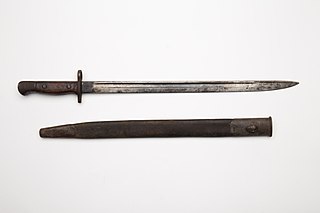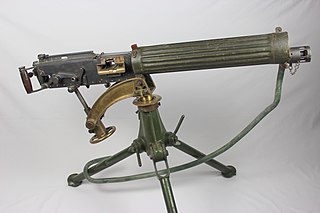 W
WThe 1.59-inch Breech-Loading Vickers Q.F. Gun, Mk II was a British light artillery piece designed during World War I. Originally intended for use in trench warfare, it was instead tested for air-to-air and air-to-ground use by aircraft. Although it fired shells and had no capability to launch rockets, it was widely but misleadingly known as the "Vickers-Crayford rocket gun."
 W
WThe Colt New Service is a large frame, large caliber, double-action revolver made by Colt from 1898 until 1941. Made in various calibers, the .45 Colt version with a 5½" barrel, was adopted by the U.S. Armed Forces as the Model 1909.
 W
WThe Garland trench mortar was an improvised mortar used by Australian and British forces at Gallipoli during the Dardanelles Campaign of 1915–16. Developed early in the war by Herbert Garland, a pre-war metallurgist and superintendent of laboratories at the Cairo Citadel, it was the most numerous mortar of the Gallipoli Campaign. A simple, improvised design, the Garland mortar consisted of a smoothbore steel barrel fixed at 45 degrees to a solid wooden base. By means of a powder charge it propelled a variant of the jam tin grenade. Its design meant that the whole weapon had to be turned to change its traverse and raised on a box to increase its range but despite these limitations it was reported to have done "good work" in the front line.
 W
WThe Lee–Enfield is a bolt-action, magazine-fed repeating rifle that served as the main firearm used by the military forces of the British Empire and Commonwealth during the first half of the 20th century. It was the British Army's standard rifle from its official adoption in 1895 until 1957. The WWI versions are often referred to as the "SMLE", which is short for the common "Short, Magazine, Lee–Enfield" variant.
 W
WThe Lewis gun is a First World War–era light machine gun. Designed privately in America but not adopted, the design was finalised and mass-produced in the United Kingdom, and widely used by troops of the British Empire during the war. It had a distinctive barrel cooling shroud and top-mounted pan magazine. The Lewis served to the end of the Korean War, and was widely used as an aircraft machine gun during both World Wars, almost always with the cooling shroud removed, as air flow during flight offers sufficient cooling.
 W
WThe Pattern 1907 bayonet, officially called the Sword bayonet, pattern 1907 , was a British bayonet designed to be used with the Short Magazine Lee Enfield (SMLE) rifle. The Pattern 1907 bayonet was used by the British and Commonwealth forces throughout both the First and Second World Wars.
 W
WThe Rifle, .303 Pattern 1914 was a British service rifle of the First World War period. A bolt action weapon with an integral 5-round magazine, it was principally contract manufactured by companies in the United States. It served as a sniper rifle and as second line and reserve issue until being declared obsolete in 1947. The Pattern 1914 Enfield was the successor to the Pattern 1913 Enfield experimental rifle and the predecessor of the U.S. Rifle M1917 Enfield.
 W
WThe Arbalète sauterelle type A, or simply Sauterelle, was a bomb-throwing crossbow used by French and British forces on the Western Front during World War I. It was designed to throw a hand grenade in a high trajectory into enemy trenches. It was initially dismissed by the French Army but General Henri Berthelot thought it had practical value.
 W
WThe Triple Lock, officially the Smith & Wesson .44 Hand Ejector 1st Model New Century, is a double-action revolver. It was and is considered by many, including handgun enthusiast and expert Elmer Keith, to be the finest revolver ever made.
 W
WThe Stokes mortar was a British trench mortar designed by Sir Wilfred Stokes KBE that was issued to the British and U.S. armies, as well as the Portuguese Expeditionary Corps, during the latter half of the First World War. The 3-inch trench mortar is a smooth-bore, muzzle-loading weapon for high angles of fire. Although it is called a 3-inch mortar, its bore is actually 3.2 inches or 81 mm.
 W
WThe Vickers machine gun or Vickers gun is a name primarily used to refer to the water-cooled .303 British (7.7 mm) machine gun produced by Vickers Limited, originally for the British Army. The machine gun typically required a six- to eight-man team to operate: one fired, one fed the ammunition, the rest helped to carry the weapon, its ammunition, and spare parts. Not to be confused with the Maxim machine gun, it was in service from before the First World War until the 1960s, with air-cooled versions of it on many Allied World War I fighter aircraft.
 W
WThe 1.59-inch Breech-Loading Vickers Q.F. Gun, Mk II was a British light artillery piece designed during World War I. Originally intended for use in trench warfare, it was instead tested for air-to-air and air-to-ground use by aircraft. Although it fired shells and had no capability to launch rockets, it was widely but misleadingly known as the "Vickers-Crayford rocket gun."
 W
WThe Webley Revolver was, in various marks, a standard issue service revolver for the armed forces of the United Kingdom, the British Empire and the Commonwealth, from 1887 until 1970.
 W
WThe Webley Self-Loading Pistol was an early magazine-fed pistol. The gun was designed in 1910 by the Webley & Scott company. The Mk. 1 entered police service in 1911 in a .32 ACP model for the London Metropolitan Police. The .455 version was adopted by the Royal Navy in 1912 as the first automatic pistol in British service. The pistol was also adopted by the Royal Horse Artillery and the Royal Flying Corps. Its predecessor was the unsuccessful Mars Automatic Pistol.
 W
WThe West Spring Gun was a bomb-throwing catapult used by British, Canadian and Australian forces during World War I. It was designed to throw a hand grenade in a high trajectory into enemy trenches.